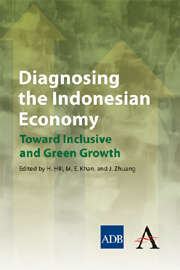Book contents
- Frontmatter
- Foreword
- Preface
- Author Profiles
- Abbreviations and Acronyms
- Contents
- 1 Introduction
- 2 Development Policies and Performance
- 3 Critical Constraints to Growth
- 4 Critical Constraints to Reducing Poverty and Inequality
- 5 Macroeconomic Management
- 6 Industrialization: Patterns, Issues, and Constraints
- 7 Infrastructure Development: Challenges and the Way Forward
- 8 Human Capital and Economic Development
- 9 Economic Growth, Employment Creation, and Poverty Alleviation
- 10 Poverty Reduction: The Track Record and Way Forward
- 11 Decentralization
- 12 Making Indonesia's Growth Green and Resilient
- Index
Preface
Published online by Cambridge University Press: 05 May 2012
- Frontmatter
- Foreword
- Preface
- Author Profiles
- Abbreviations and Acronyms
- Contents
- 1 Introduction
- 2 Development Policies and Performance
- 3 Critical Constraints to Growth
- 4 Critical Constraints to Reducing Poverty and Inequality
- 5 Macroeconomic Management
- 6 Industrialization: Patterns, Issues, and Constraints
- 7 Infrastructure Development: Challenges and the Way Forward
- 8 Human Capital and Economic Development
- 9 Economic Growth, Employment Creation, and Poverty Alleviation
- 10 Poverty Reduction: The Track Record and Way Forward
- 11 Decentralization
- 12 Making Indonesia's Growth Green and Resilient
- Index
Summary
Indonesia has experienced sharply fluctuating fortunes for the last half century. In the early 1960s, the economy was stagnating, and hyperinflation threatened to further erode living standards. The country, described in the leading development economics textbook as a “chronic economic dropout,” was disengaging from the international economic community. Then, in a remarkable turnabout following the regime change of 1965–1966, the new administration signaled a return to economic orthodoxy, and economic growth accelerated. Over the next three decades the economy quadrupled in size, and poverty incidence fell rapidly. However, Indonesia's socioeconomic progress was threatened again by the Asian financial crisis of 1997. It was the worst aff ected country during the crisis period, principally because it experienced twin crises—both economic and political. In 1998, not only did the modern financial sector and the exchange rate collapse, but there was also a brief episode of hyperinflation and the very real possibility of territorial disintegration.
However, Indonesia navigated these crises with great success. It is now the world's third most populous democracy, having completed two rounds of nationwide elections for the national government and the approximately 500 subnational units of government. The new institutional arrangements for government are in place and are becoming firmly embedded through enthusiastic democratic participation. The country survived the global financial crisis of 2008–2009 with little growth deceleration and is currently enjoying record terms of trade.
- Type
- Chapter
- Information
- Diagnosing the Indonesian EconomyToward Inclusive and Green Growth, pp. vii - viiiPublisher: Anthem PressPrint publication year: 2012



